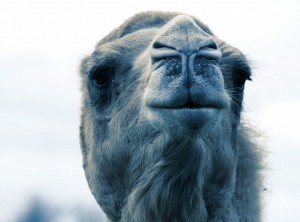 Camels are central to Somaliland culture and sustainability issues, but it wasn’t until my third visit there that I actually saw these important creatures. I learned of their central role in Somaliland as I participated in a joint project between the University of Hargeisa (UOH) and the Center for Justice and Peacebuilding at Eastern Mennonite University. Our partnership was to develop an Institute for Conflict and Peace Studies at UOH and for me and local colleague, Muhyadin Saed, to research the relationship between Customary Law and Conflict Transformation in the Somaliland context. It was the research that more fully introduced me to the importance of camels in Somali culture and how in conflict situations they are used to resolve the conflict and regulate relationships.
Camels are central to Somaliland culture and sustainability issues, but it wasn’t until my third visit there that I actually saw these important creatures. I learned of their central role in Somaliland as I participated in a joint project between the University of Hargeisa (UOH) and the Center for Justice and Peacebuilding at Eastern Mennonite University. Our partnership was to develop an Institute for Conflict and Peace Studies at UOH and for me and local colleague, Muhyadin Saed, to research the relationship between Customary Law and Conflict Transformation in the Somaliland context. It was the research that more fully introduced me to the importance of camels in Somali culture and how in conflict situations they are used to resolve the conflict and regulate relationships.
Somaliland’s customary law (xeer) determines daily life and is used to address a range of conflicts, including murder. This is where camels play a major role. For example: If a clan member is murdered by someone from a different clan, a council of elders from both sides will meet to hear the case and determine the punishment of the offender. In a case I became familiar with, the offender’s clan had to pay the family member of the victim and his clan a total of 120 camels. This is a significant number of animals that represented the loss of meat, milk and status to the offender’s clan, but symbolically addressed the loss of life of the victim for his family and clan.
Although the exchange of camels for such a crime is still very much practiced in rural Somaliland, urbanization is growing due to wide-spread drought and the drive to modernize. Therefore money is used in a growing number of these transactions. One camel is the equivalent of 100 US dollars. For the murder noted above, $12,000 would have to be paid as restitution to the victim’s family. In context, it shows the great worth of the camel and its centrality in the issues of life and death in the Somali culture. So when I did see my first camel, I already had a great appreciation for its status and value to local people. Within the framework of Somaliland customary law, the camel is king.
Read on for Barry’s article, co-written with Muhyadin Saed, in the December 2010 issue of the Africa Peace and Conflict Journal (Vol. 3 No. 2): Integrating Principles and Practices of Customary Law, ConflictTransformation,and Restorative Justice in Somaliland
 [Barry Hart is currently the Academic Director at EMU’s Center for Justice and Peacebuilding, and is Professor of Trauma, Identity, and Conflict Studies. Camel photo by doug88888 via Flickr, under CC license.]
[Barry Hart is currently the Academic Director at EMU’s Center for Justice and Peacebuilding, and is Professor of Trauma, Identity, and Conflict Studies. Camel photo by doug88888 via Flickr, under CC license.]

The camel is very important to the people of the Gobi Desert as well.
It was a very interesting article and I can understand the status of a camel to a clan and I guess it would be a great deterent to people as the clan suffer for your crimes as well as you!! Nothing like peer pressure! Perhaps we should introduce them into our society!!!